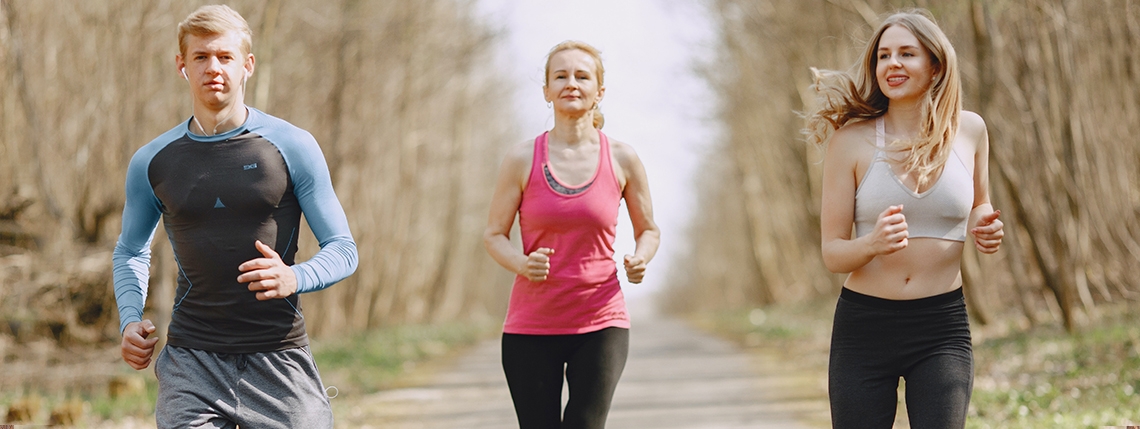Are you gearing up to start delivering sessions outside?
With outdoor training sessions seeming increasingly possible across the UK again, Sarah Adkin, encourages you to embrace the great outdoors.
Sarah discusses some important considerations, tips and advice to help you to deliver safe and effective outdoor training sessions.
Not just good for social distancing
There are, of course, many benefits to outdoor exercise – in addition to the ease of social distancing and the lowered risk of transmitting viral infections – such as:
- helping reduce depression, anxiety and anger, due to increased vitamin D intake1
- reducing blood pressure and stress2
- potentially burning more calories due to the extra energy your body needs to regulate your body temperature.3
However, there are challenges to consider when delivering outside.
Location, location, location
A very important consideration when choosing your location is the practicalities of the space for the style of class you are running. Do you need a flat surface or a large space? Can you make use of any structures for your workout (think resistance bands around a fence or railings as a ballet barre)? Is it important to be within easy reach of toilets? Is there adequate lighting after dark?
The great British weather
Unfortunately, the weather is one aspect we can’t control. The second very important consideration is appropriate programming according to the conditions.
When programming a class for the cold, make sure it is as dynamic as possible and keep static stretches to maintenance rather than developmental. Avoid long periods of inactivity, for example, when demonstrating a circuit give your class a movement to do while watching. Also include exercises that increase circulation to the fingers and toes, such as wrist and ankle circles. If you’re practising yoga in the cold, toe squats are a good choice.
When there is potential for rain, you’ll need to focus on safety, as well as comfort. Avoid speed-based exercises due to slippery surfaces, and avoid exercises where hands or knees need to come to the ground or move to a sheltered area if possible.
In the heat, remind participants to bring water and always carry spare, just in case. It’s wise to significantly reduce the intensity of the class and advisable to deliver in a shaded location if possible.
A final consideration is everyone’s personal belongings; bring a plastic or tarpaulin sheet to keep everything dry.
Local licensing
There is no one answer to whether permission or licensing is required, as the regulations vary from council to council. Some do not require it, some have licensing procedures and some require you to pay. Find out who owns the space and reach out to them.
Health and safety
Health and safety considerations are different from those within a gym environment. Many councils require you to submit a risk assessment; even if they don’t, it’s good practice to do so. Check the space for any potential hazards.
Be particularly vigilant about equipment being left as a trip hazard, and make sure your class does not significantly obstruct any public pathways. Always carry a first aid kit with you when teaching outdoors.
However, accidents can still happen during a session and you need to be prepared for that eventuality. This is why having the right insurance is so important.
The FitPro Instructor Public and Teacher Liability (Professional Indemnity) insurance covers qualified fitness instructors in gyms, studios, online and outdoors.
If you would like more information about the range of insurance coverage that FitPro provides CLICK HERE or contact a member of our insurance team via info@fitpro.com or +44 (0)20 8586 0101
Eager for more advice on setting up your own outdoor training sessions? Sarah recently delivered a webinar exploring this topic in more depth and, as a Professional member, you can access the recording of this and all previous monthly webinars HERE
Where to next? Read our reviews of the best hiking shoes
References
- Thompson Coon J, Boddy K, Stein K, Whear R, Barton J, Depledge MH (2011), Does participating in physical activity in outdoor natural environments have a greater effect on physical and mental wellbeing than physical activity indoors? A systematic review, Environmental Science & Technology, 45(5), 1761-1772. doi: http://dx.doi.org/10.1021/es102947t, accessed on 19 January 2021.
- Park BJ, Tsunetsugu Y, Kasetani T, Kagawa T, Miyazaki Y (2011), The physiological effects of Shinrin-yoku (taking in the forest atmosphere or forest bathing): Evidence from field experiments in 24 forests across Japan, Environmental Health Preventative Medicine, 15(1), 18-26. doi: https://pubmed.ncbi.nlm.nih.gov/19568835/, accessed on 19 January 2021.
- Ocobock CJ (2017), Body fat attenuates muscle mass catabolism among physically active humans in temperate and cold high altitude environments, Am J Hum Biol, 10: 29(5). doi: https://doi.org/10.1002/ajhb.23013, accessed on 19 January 2021.
Author bio

Sarah Adkin is an experienced outdoor group fitness instructor and community manager at BUA FIT. buafit.co.uk







